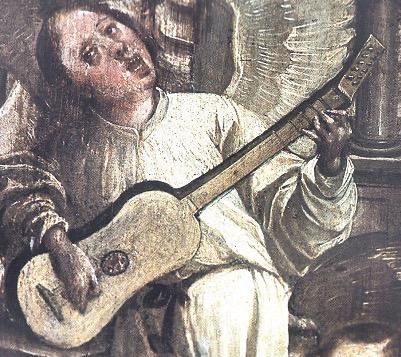Angel vihuelist from Abrantes, after 1548.
(1548) - Abrantes (Portugal), Igreja da Misericordia.
instrument: vihuela de mano | century: 16cent/2/mid | catalogue nº: 16-225

Artwork
Creator Maestro de Abrantes
Medium Artwork: Fresco
Location
City Abrantes | Region Portugal | Old kingdom Portugal
Characteristics
| Body Waisted | Strings 6 courses | Neck Long | Pegbox Angled flat |
| Bridge Fixed | Frets Yes | Back Flat | Pegs Rear |
| Technique Plucked fingers thumb out |
Commentary
ARTWORK
Natividad. by the Maestro de Abrantes (active 1540 -1578), Igreja da Misericordia, Abrantes (Portugal). The church was built in 1548. The painting is estimated to date from the 1550s or 1560s.
INSTRUMENT
A six course vihuela: 5x2; 1x1 strings, Waisted body with two shoulders of equal width, a fixed bridge ath the lower end of the soundboard and a circular rosette at exactly half-way along the soundboard. It appears to be a shallow instrument with a flat back. The neck is very long (join at frets 14-15), ending in a flat angled pegbox with rear pegs. It is being played with the right hand perpendicular to the strings and thus with the thumb out.
• Alexander Batov writes (2006) (https://www.vihuelademano.com/abrantes-vihuela.htm, accessed 12/05/2020):
“This instrument shows what appears to be a six-course viola / vihuela which is provided with eleven pegs for strings in its peg head. To my knowledge this is the only existing source of iconographical evidence known to the present day that, in a way, serves as visual confirmation to what one of the late-16th century historical records refers to as an ‘eleven string viola’.
“The pegs are arranged in two rows, five on the left and six on the right side of the peg head [left picture] and thus illustrating that an uneven peg number was indeed a feature of organological diversity in 16th century vihuela construction. At least two other representations showing similar, non-symmetric ways of peg arrangement, this time on four-course guitars [top and bottom right pictures], have survived: on a self-portrait of David Teniers le Jeune (1610 – 1690) and on a pilaster fragment of the Duomo of Cremona (c. 1560).
“Although fragmentary, the depicted instrument is remarkable in a few other details: the long shallow neck corresponding with an equally shallow string band on the bridge, the core of the neck that is shaped so that it comes to the full depth of the sides at the join with the body and a rather pronounced stretch in the the middle bouts area of the body which results in the long slender curve of the outline. All these features are remarkably similar to those of the Belchior Dias 1581 vihuela from the Royal College of Music London, needless to say the eleven-peg feature itself!”
• Manuel Morais (in an e-mail to vihue-lista 28-dec-2007) cautions that the source is not reliable “Para os posíveis interessados na iconografia musical portuguesa do séc. XVI, acrescento que este quadro não está em estado original, tendo-lhe sido feito muitos repintes. Por esta razão, a Viola aí representada não é fiável do ponto de vista iconográfico, nem serve de base para uma descrição organológico deste cordofone de mão.”
(For those who may be interested in the Portuguese musical iconography of the 16th century, I would add that this painting is not in its original state, having been repainted many times. For this reason, the Viola represented there is not reliable from an iconographic point of view, nor does it serve as a basis for an organological description of this hand-held cordophone)